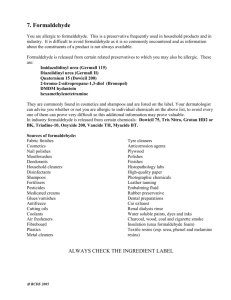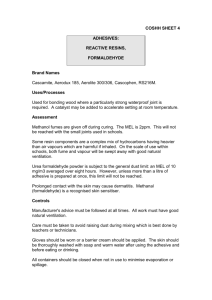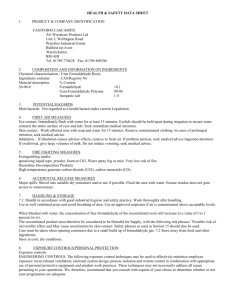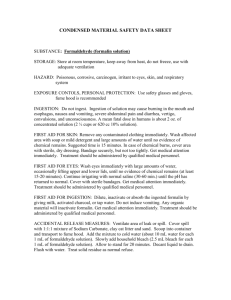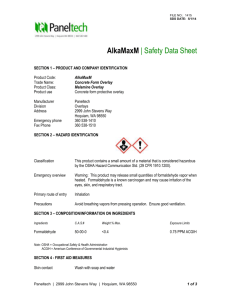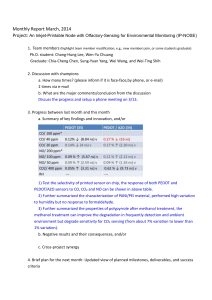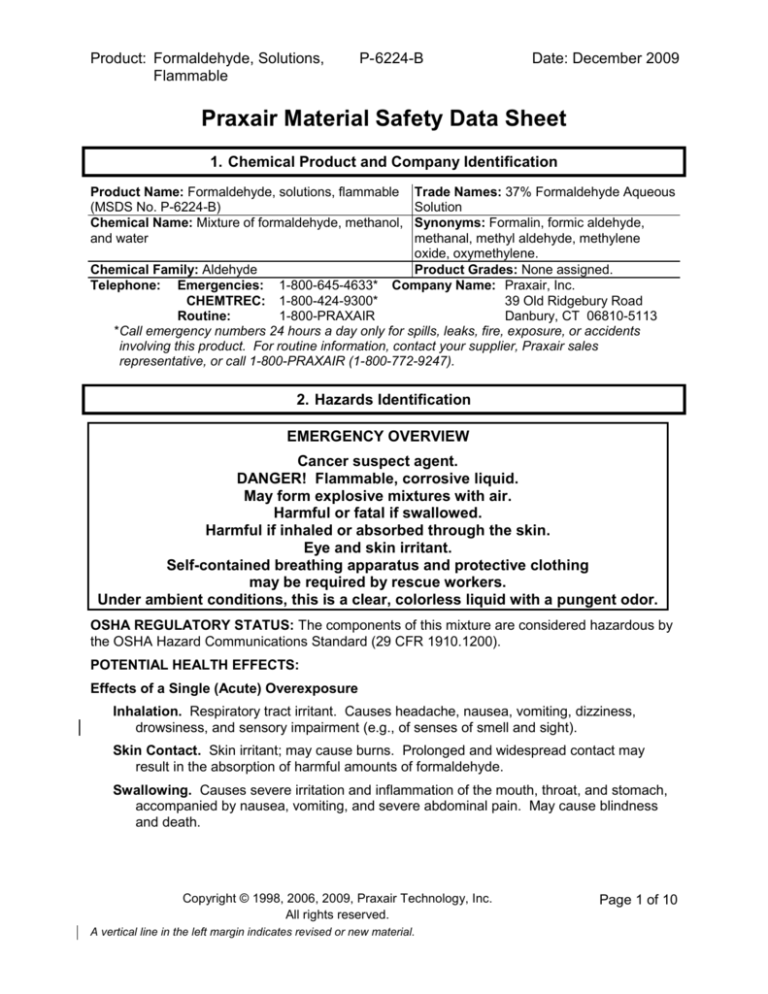
Product: Formaldehyde, Solutions,
Flammable
P- 6224-B
Date: December 2009
Praxair Material Safety Data Sheet
1. Chemical Product and Company Identification
Product Name: Formaldehyde, solutions, flammable
(MSDS No. P-6224-B)
Chemical Name: Mixture of formaldehyde, methanol,
and water
Trade Names: 37% Formaldehyde Aqueous
Solution
Synonyms: Formalin, formic aldehyde,
methanal, methyl aldehyde, methylene
oxide, oxymethylene.
Chemical Family: Aldehyde
Product Grades: None assigned.
Telephone: Emergencies: 1-800-645-4633* Company Name: Praxair, Inc.
CHEMTREC: 1-800-424-9300*
39 Old Ridgebury Road
Routine:
1-800-PRAXAIR
Danbury, CT 06810-5113
* Call emergency numbers 24 hours a day only for spills, leaks, fire, exposure, or accidents
involving this product. For routine information, contact your supplier, Praxair sales
representative, or call 1-800-PRAXAIR (1-800-772-9247).
2. Hazards Identification
EMERGENCY OVERVIEW
Cancer suspect agent.
DANGER! Flammable, corrosive liquid.
May form explosive mixtures with air.
Harmful or fatal if swallowed.
Harmful if inhaled or absorbed through the skin.
Eye and skin irritant.
Self-contained breathing apparatus and protective clothing
may be required by rescue workers.
Under ambient conditions, this is a clear, colorless liquid with a pungent odor.
OSHA REGULATORY STATUS: The components of this mixture are considered hazardous by
the OSHA Hazard Communications Standard (29 CFR 1910.1200).
POTENTIAL HEALTH EFFECTS:
Effects of a Single (Acute) Overexposure
Inhalation. Respiratory tract irritant. Causes headache, nausea, vomiting, dizziness,
drowsiness, and sensory impairment (e.g., of senses of smell and sight).
Skin Contact. Skin irritant; may cause burns. Prolonged and widespread contact may
result in the absorption of harmful amounts of formaldehyde.
Swallowing. Causes severe irritation and inflammation of the mouth, throat, and stomach,
accompanied by nausea, vomiting, and severe abdominal pain. May cause blindness
and death.
Copyright © 1998, 2006, 2009, Praxair Technology, Inc.
All rights reserved.
A vertical line in the left margin indicates revised or new material.
Page 1 of 10
Product: Formaldehyde, Solutions,
Flammable
P- 6224-B
Date: December 2009
Eye Contact. Severe eye irritant. Vapors may cause severe irritation and tearing. Liquid
may cause permanent eye injury from chemical burns.
Effects of Repeated (Chronic) Overexposure. May cause skin sensitization. May cause liver
and kidney damage.
Other Effects of Overexposure. None known.
Medical Conditions Aggravated by Overexposure. Formaldehyde may aggravate an
existing eye, skin, or respiratory condition. The potential to cause liver and kidney injury may
exacerbate existing liver and/or kidney diseases.
CARCINOGENICITY: ACGIH (2009) lists formaldehyde as a suspected human carcinogen (A2)
because it causes cancer in experimental animals under conditions considered relevant to
human exposure. Formaldehyde is listed by NTP and OSHA as a potential cancer hazard.
OSHA has established OSHA Standard 1910.1048, Formaldehyde, governing its handling and
use. IARC deems formaldehyde to be carcinogenic to humans.
POTENTIAL ENVIRONMENTAL EFFECTS:
Environmental Fate—Formaldehyde. Released into soil. Should leach into groundwater.
Released into water. Should readily biodegrade without significant accumulation. Significant
evaporation not expected. Released into air. Should be readily degraded by reaction with
photochemically produced hydroxyl radicals and photolysis. Should readily be removed from
the atmosphere by dry and wet deposition. Should have a half-life of less than 1 day.
Environmental Fate—Methanol. Released into soil. Should readily biodegrade and is
expected to leach into groundwater. Released into water. Should readily biodegrade without
significant accumulation and quickly evaporate. Should have a half-life from 1 and 10 days.
Released into air. Should be readily degraded by reaction with photochemically produced
hydroxyl radicals and readily removed from the atmosphere by wet deposition. Should have a
half-life between 10 and 30 days. For further information, see section 12, Ecological
Information.
3. Composition/Information on Ingredients
See section 16 for important information about mixtures.
COMPONENT
Formaldehyde
Water
Methanol
*The symbol > means “greater than.”
CAS NUMBER
50-00-0
7732-18-5
67-56-1
CONCENTRATION
37%
>62%*
0.1-0.3%
4. First Aid Measures
INHALATION: Immediately remove to fresh air. If not breathing, give artificial respiration. If
breathing is difficult, qualified personnel may give oxygen. Call a physician.
SKIN CONTACT: Remove contaminated clothing and shoes. Flush skin with copious amounts
of water.
SWALLOWING: Do not induce vomiting. If conscious, give water or milk. Get immediate
medical attention.
Page 2 of 10
Product: Formaldehyde, Solutions,
Flammable
P- 6224-B
Date: December 2009
EYE CONTACT: Flush eyes thoroughly with water for at least 15 minutes. Hold the eyelids
open and away from the eyeballs to ensure that all surfaces are flushed thoroughly.
Immediately see a physician, preferably an ophthalmologist.
NOTES TO PHYSICIAN: There is no specific antidote. Treatment of overexposure should be
directed at the control of symptoms and the clinical condition of the patient.
5. Fire Fighting Measures
FLAMMABLE PROPERTIES: May form explosive mixtures with air and oxidizing agents.
SUITABLE EXTINGUISHING MEDIA: CO2, dry chemical foam. Water may be ineffective. Use
water spray or fog to reduce flammable vapors.
PRODUCTS OF COMBUSTION: Formaldehyde, carbon monoxide, carbon dioxide
PROTECTION OF FIREFIGHTERS: DANGER! Flammable, corrosive liquid. Evacuate all
personnel from danger area. Remove sources of ignition if without risk. Do not extinguish any
flames emitted from containers; stop flow if without risk, or allow flames to burn out.
Reapproach with extreme caution using self-contained breathing apparatus and protective
clothing. On-site fire brigades must comply with OSHA 29 CFR 1910.156.
Specific Physical and Chemical Hazards. If venting or leaking formaldehyde catches fire, do
not extinguish flames. Flammable vapors are heavier than air and may spread extensively from
leak, creating an explosive re-ignition hazard at considerable distances from the source.
Vapors can be ignited by pilot lights, other flames, smoking, sparks, heaters, electrical
equipment, static discharge, or other ignition sources at locations distant from product handling
point. Explosive atmospheres may linger. Before entering area, especially confined areas,
check atmosphere with an approved explosion meter.
Protective Equipment and Precautions for Firefighters. Firefighters should wear selfcontained breathing apparatus and full fire-fighting turnout gear.
6. Accidental Release Measures
STEPS TO BE TAKEN IF MATERIAL IS RELEASED OR SPILLED:
DANGER! Flammable, corrosive liquid.
Personal Precautions. May form explosive mixtures with air. Immediately evacuate all
personnel from danger area. Use self-contained breathing apparatus and protective clothing
where needed. Remove all sources of ignition if without risk. Reduce vapors with fog or fine
water spray, taking care to prevent runoff. Shut off flow if without risk. Ventilate area.
Flammable vapors may spread from spill. Before entering area, especially confined areas,
check atmosphere with an appropriate device. Absorb spill with an inert material and place into
containers for later disposal.
Environmental Precautions. Prevent waste from contaminating the surrounding environment.
Keep personnel away. Discard any product, residue, disposable container, or liner in an
environmentally acceptable manner, in full compliance with federal, state, and local regulations.
If necessary, call your local supplier for assistance.
7. Handling and Storage
PRECAUTIONS TO BE TAKEN IN HANDLING: Vapors are toxic and can cause symptoms of
suffocation due to oxygen deficiency. Store and use with adequate ventilation. Keep containers
Page 3 of 10
Product: Formaldehyde, Solutions,
Flammable
P- 6224-B
Date: December 2009
and container valves tightly closed when not in use, even when empty. Do not eat, drink, or
smoke in areas where formaldehyde is used or stored. Wash hands and face thoroughly to
clean them of any residual product before eating, drinking, smoking, using the toilet, or applying
cosmetics. Protect containers from damage. Use only spark-proof tools and explosion-proof
equipment. Keep away from heat, sparks, and open flame. Leak check system with soapy
water; never use a flame. Slowly and carefully open formaldehyde valves. For other
precautions in using this solution, see section 16.
PRECAUTIONS TO BE TAKEN IN STORAGE: Store and use with adequate ventilation. Never
store formaldehyde in open containers or containers made of incompatible materials. (See
section 10.) Store formaldehyde containers in approved storage cabinets for flammable liquids.
Otherwise, separate from oxygen, chlorine, and other oxidizers by at least 20 ft (6.1 m), or use a
barricade of noncombustible material. This barricade should be at least 5 ft (1.53 m) high and
have a fire resistance rating of at least ½ hour. Firmly secure containers upright to keep them
from falling or being knocked over. Keep valves tightly closed. Post "No Smoking or Open
Flames" signs in storage and use areas. There must be no sources of ignition. All electrical
equipment in storage areas must be explosion-proof. Storage areas must meet national electric
codes for Class 1 hazardous areas. Store only where temperature will not exceed 125°F
(52°C). Store full and empty containers separately. Use a first-in, first-out inventory system to
prevent storing full containers for long periods.
8. Exposure Controls/Personal Protection
COMPONENT
Formaldehyde
Water
Methanol
OSHA PEL
0.75 ppm; 2 ppm, 15-min (STEL)
N.E.**
200 ppm
ACGIH TLV-TWA (2009)
0.3 ppm (c)*
N.E.**
200 ppm; 250 ppm, 15-min
STEL, skin
*(c) – Ceiling values are not Time-Weighted-Average (TWA).
**N.E.–Not Established.
TLV-TWAs should be used as a guide in the control of health hazards and not as fine lines
between safe and dangerous concentrations.
IDLH = 20 ppm (formaldehyde); 6000 ppm (methanol)
ENGINEERING CONTROLS:
Local Exhaust. Use an explosion-proof local exhaust ventilation system with sufficient air flow
velocity to maintain the concentration of formaldehyde vapors below all applicable exposure
limits in the worker's breathing zone.
Mechanical (General). May be the only practical control method if devices emitting
formaldehyde are widely dispersed.
Special. None
Other. None
PERSONAL PROTECTIVE EQUIPMENT:
Skin Protection. Wear work gloves for container handling; plastic or rubber gloves where
exposure to liquid may occur. Protective clothing and footwear where needed. Select in
accordance with OSHA 29 CFR 1910.132 and 1910.133. Regardless of protective equipment,
never touch live electrical parts.
Page 4 of 10
Product: Formaldehyde, Solutions,
Flammable
P- 6224-B
Date: December 2009
Eye/Face Protection. Wear safety glasses and a full face shield. Select in accordance with
OSHA 29 CFR 1910.133.
Respiratory Protection. A respiratory protection program that meet OSHA 29 CFR 1910.134,
ANSI Z88.2, or MSHA 30 CFR 72.710 (where applicable) requirements must be followed
whenever workplace conditions warrant respirator use. Use an air-supplied or air-purifying
cartridge if the action level is exceeded. Ensure that the respirator has the appropriate
protection factor for the exposure level. If cartridge type respirators are used, the cartridge must
be appropriate for the chemical exposure (e.g., an organic vapor cartridge). For emergencies or
instances with unknown exposure levels, use a self-contained breathing apparatus. Refer to
OSHA 29 CFR 1910.1048 for respiratory protection requirements.
9. Physical and Chemical Properties
APPEARANCE:
ODOR:
ODOR THRESHOLD:
PHYSICAL STATE:
pH:
MELTING POINT at 1 atm:
BOILING POINT at 1 atm:
FLASH POINT (test method):
EVAPORATION RATE (Butyl Acetate = 1):
FLAMMABILITY:
FLAMMABLE LIMITS IN AIR, % by volume:
VAPOR PRESSURE at 68°F (20°C):
VAPOR DENSITY at 68°F (20°C):
SPECIFIC GRAVITY (H2O = 1) at 68°F (20°C) and
1 atm:
SPECIFIC GRAVITY (Air = 1) at 68°F (20°C):
SOLUBILITY IN WATER 68°F (20°C):
PARTITION COEFFICIENT: n-octanol/water:
AUTOIGNITION TEMPERATURE:
DECOMPOSITION TEMPERATURE:
PERCENT VOLATILES BY VOLUME:
MOLECULAR WEIGHT:
MOLECULAR FORMULA:
Clear, colorless liquid
Pungent
0.8 – 1.0 ppm
Liquid at normal temperature and pressure
2.8 – 4.0
Not available.
214°F (101°C)
185°F (85°C) (closed cup)
Not available.
Flammable
LOWER: 7%
UPPER: 73%
0.078 lb/ft3 (1.25 kg/m3) (calculated)
Not available.
1.075
1.04
Miscible
Not available.
806°F (430°C)
Not available.
Not available.
30.03 (formaldehyde), 32.04 (methanol)
Mixture of HCHO, CH3OH, & H2O
10. Stability and Reactivity
CHEMICAL STABILITY:
Unstable
Stable
CONDITIONS TO AVOID: Polymerization catalysts
INCOMPATIBLE MATERIALS: Strong oxidizers, strong alkalies, and acids (such as
hydrochloric acid, nitric acid, chromic acid, and perchloric acid), alkali metals, amines and
ammonia, phenol, and reducing agents.
HAZARDOUS DECOMPOSITION PRODUCTS: Fumes of formaldehyde gas
Page 5 of 10
Product: Formaldehyde, Solutions,
Flammable
P- 6224-B
POSSIBILITY OF HAZARDOUS REACTIONS:
May Occur
Date: December 2009
Will Not Occur
May react with alkalies and oxidizing materials such as peroxides, nitric acid, and chromic acid.
Formic acid decomposes slowly during storage and more rapidly under fire conditions, forming
carbon monoxide.
11. Toxicological Information
ACUTE DOSE EFFECTS: For formaldehyde: LD50=800 mg/kg, oral, rat; LD50=42 mg/kg, oral,
mouse; LCLo=250 mg/kg, inhalation, rat. LCLo=900 mg/kg, inhalation, mouse; LC50=590 mg/kg,
inhalation, rat. For methanol: LD50=5,628 mg/kg, oral, rat; LD50=7,300 mg/kg, oral, mouse;
LD50=12,880 mg/kg, oral rat; LD50=14,200 mg/kg, oral rabbit.
STUDY RESULTS: Prolonged or repeated exposure to formaldehyde may result in respiratory
impairment. Rats exposed to formaldehyde at 2 ppm developed benign nasal tumors and
changes of the cell structure in the nose as well as inflamed mucous membranes of the nose.
Structural changes in the epithelial cells in the human nose have also been observed. Some
persons have developed asthma or bronchitis following exposure to formaldehyde, most often
as the result of an accidental spill involving a single exposure to a high concentration of
formaldehyde.
12. Ecological Information
ECOTOXICITY: The following toxicity information is for formaldehyde: 96 Hr LC50 fathead
minnow, 24.1 mg/L (flow-through); 96 Hr LC50 bluegill, 0.10 mg/L (flow-through); 96 Hr EC50
water flea, 20 mg/L. The methanol portion is expected to be slightly toxic to aquatic life. The
LC50/96 Hr values for fish are between 10 and 100 mg/L.
OTHER ADVERSE EFFECTS: This solution does not contain any Class I or Class II ozonedepleting chemicals.
13. Disposal Considerations
WASTE DISPOSAL METHOD: Do not attempt to dispose of residual or unused quantities.
Return container to supplier. See section 6.
14. Transport Information
DOT/IMO SHIPPING NAME:
Formaldehyde, solutions, flammable
HAZARD
PACKING
IDENTIFICATION
CLASS:
3
GROUP/Zone: III
NUMBER:
UN1198
PRODUCT
RQ:
100 lb
(45.4 kg)
SHIPPING LABEL(s):
FLAMMABLE LIQUID, CORROSIVE
PLACARD (when required):
FLAMMABLE LIQUID, CORROSIVE
SPECIAL SHIPPING INFORMATION: Containers should be transported in a secure position, in
a well-ventilated vehicle. Containers transported in an enclosed, nonventilated compartment of
a vehicle can present serious safety hazards.
MARINE POLLUTANTS: Formaldehyde is not listed as a marine pollutant by the DOT.
Page 6 of 10
Product: Formaldehyde, Solutions,
Flammable
P- 6224-B
Date: December 2009
15. Regulatory Information
The following selected regulatory requirements may apply to this product. Not all such
requirements are identified. Users of this product are solely responsible for compliance with all
applicable federal, state, and local regulations.
U.S. FEDERAL REGULATIONS:
EPA (ENVIRONMENTAL PROTECTION AGENCY)
CERCLA: COMPREHENSIVE ENVIRONMENTAL RESPONSE, COMPENSATION,
AND LIABILITY ACT OF 1980 (40 CFR Parts 117 and 302):
Reportable Quantity (RQ): 100 lb (45.4 kg)
SARA: SUPERFUND AMENDMENT AND REAUTHORIZATION ACT:
SECTIONS 302/304: Require emergency planning based on Threshold Planning
Quantity (TPQ) and release reporting based on Reportable Quantities (RQ) of
Extremely Hazardous Substances (EHS) (40 CFR Part 355):
TPQ: 500 lb (227 kg)
EHS RQ (40 CFR 355): 100 lb (45.4 kg)
SECTIONS 311/312: Require submission of MSDSs and reporting of chemical
inventories with identification of EPA hazard categories. The hazard categories for
this product are as follows:
IMMEDIATE: Yes
PRESSURE: No
DELAYED: Yes
REACTIVITY: Yes
FIRE: Yes
SECTION 313: Requires submission of annual reports of release of toxic chemicals
that appear in 40 CFR Part 372.
Formaldehyde and methanol are subject to the reporting requirements of Section
313 of Title III of the Superfund Amendments and Reauthorization Act of 1986
(SARA) and 40CFR Part 372.
40 CFR 68: RISK MANAGEMENT PROGRAM FOR CHEMICAL ACCIDENTAL
RELEASE PREVENTION: Requires development and implementation of risk
management programs at facilities that manufacture, use, store, or otherwise handle
regulated substances in quantities that exceed specified thresholds.
Formaldehyde is listed as a regulated substance in quantities of 15,000 lb (6810 kg)
or greater.
TSCA: TOXIC SUBSTANCES CONTROL ACT: The components of this solution are
listed on the TSCA inventory.
OSHA: OCCUPATIONAL SAFETY AND HEALTH ADMINISTRATION:
29 CFR 1910.119: PROCESS SAFETY MANAGEMENT OF HIGHLY HAZARDOUS
CHEMICALS: Requires facilities to develop a process safety management program
based on Threshold Quantities (TQ) of highly hazardous chemicals.
Formaldehyde is listed in Appendix A as a highly hazardous chemical in quantities of
1,000 lb (454 kg) or greater.
STATE REGULATIONS:
CALIFORNIA: Formaldehyde is listed by California under the SAFE DRINKING WATER
AND TOXIC ENFORCEMENT ACT OF 1986 (Proposition 65).
WARNING: Formaldehyde is a chemical known to the State of California to cause
cancer; (California Health and Safety Code §25249.5 et seq.).
Page 7 of 10
Product: Formaldehyde, Solutions,
Flammable
P- 6224-B
Date: December 2009
PENNSYLVANIA: This product is subject to the PENNSYLVANIA WORKER AND
COMMUNITY RIGHT-TO-KNOW ACT (35 P.S. Sections 7301-7320).
16. Other Information
Read and understand all labels and instructions supplied with all containers of this product.
OTHER HAZARDOUS CONDITIONS OF HANDLING, STORAGE, AND USE: Flammable,
corrosive liquid. May form explosive mixtures with air. Use piping and equipment adequately
designed to withstand pressures to be encountered. All piped formaldehyde systems and
associated equipment must be grounded. Use a backflow prevention device in any piping. Use
only in a closed system. Never work on an operating system. First, shut down operations.
Then, in an environmentally safe manner in compliance with all federal, state, and local laws,
depressurize the system and drain it of as much formaldehyde as possible before opening the
system or attempting to repair any leaks.
Mixtures. When you mix two or more chemicals, you can create additional, unexpected
hazards. Obtain and evaluate the safety information for each component before you produce
the mixture. Consult an industrial hygienist or other trained person when you evaluate the end
product. Remember, chemicals have properties that can cause serious injury or death.
HAZARD RATING SYSTEMS:
NFPA RATINGS:
HMIS RATINGS:
=2
HEALTH
= 2*
HEALTH
=2
FLAMMABILITY
=2
FLAMMABILITY
=0
INSTABILITY
PHYSICAL HAZARD = 0
SPECIAL
= None
*An asterisk used in conjunction with HMIS health hazard ratings designates a carcinogenic
or reproductive hazard.
Page 8 of 10
Product: Formaldehyde, Solutions,
Flammable
P- 6224-B
Date: December 2009
Praxair asks users of this product to study this MSDS and become aware of product hazards
and safety information. To promote safe use of this product, a user should (1) notify employees,
agents, and contractors of the information in this MSDS and of any other known product
hazards and safety information, (2) furnish this information to each purchaser of the product,
and (3) ask each purchaser to notify its employees and customers of the product hazards and
safety information.
Page 9 of 10
Product: Formaldehyde, Solutions,
Flammable
P- 6224-B
Date: December 2009
The opinions expressed herein are those of qualified experts within Praxair, Inc. We
believe that the information contained herein is current as of the date of this Material
Safety Data Sheet. Since the use of this information and the conditions of use of the
product are not within the control of Praxair, Inc., it is the user’s obligation to
determine the conditions of safe use of the product.
Praxair MSDSs are furnished on sale or delivery by Praxair or the independent distributors and suppliers
who package and sell our products. To obtain current MSDSs for these products, contact your Praxair
sales representative or local distributor or supplier, or download from www.praxair.com. If you have
questions regarding Praxair MSDSs, would like the form number and date of the latest MSDS, or would
like the names of the Praxair suppliers in your area, phone or write the Praxair Call Center (Phone: 1800-PRAXAIR; Address: Praxair Call Center, Praxair, Inc., PO Box 44, Tonawanda, NY 14151-0044).
Praxair and the Flowing Airstream design are trademarks or registered trademarks of
Praxair Technology, Inc. in the United States and/or other countries.
Praxair, Inc.
39 Old Ridgebury Road
Danbury, CT 06810-5113
Printed in USA
Page 10 of 10

